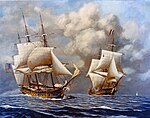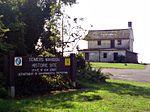B.L. England Generating Station

The B.L. England Generating Station, also called Beesley's Point Generating Station, was a power plant in Upper Township, Cape May County, New Jersey, United States, on the Great Egg Harbor River. The facility provided approximately 450 megawatts of generating capacity from three generating units. Two units burned coal (and up to 7 percent Tire-derived fuel) and the third unit burned bunker C oil. Its large smokestack, altered to resemble a lighthouse, contained a sulfur dioxide scrubber which removed the SO2 from the flue gas and converted it into gypsum, which can be sold. The scrubber allowed the two coal units to use less expensive high sulfur coal from West Virginia. The plant is visible from the Great Egg Harbor Bridge on the Garden State Parkway, and many confuse it with the Oyster Creek Nuclear Generating Station and its hyperboloid cooling tower, which recirculates hot water to avoid discharging into Great Egg Harbor Bay and cause thermal pollution. The plant was decommissioned on May 1, 2019 and has been slowly being demolished, with major demolition starting on April 21, 2023.
Excerpt from the Wikipedia article B.L. England Generating Station (License: CC BY-SA 3.0, Authors, Images).B.L. England Generating Station
Clay Avenue,
Geographical coordinates (GPS) Address Nearby Places Show on map
Geographical coordinates (GPS)
| Latitude | Longitude |
|---|---|
| N 39.289722222222 ° | E -74.633888888889 ° |
Address
Clay Avenue
08223
New Jersey, United States
Open on Google Maps









